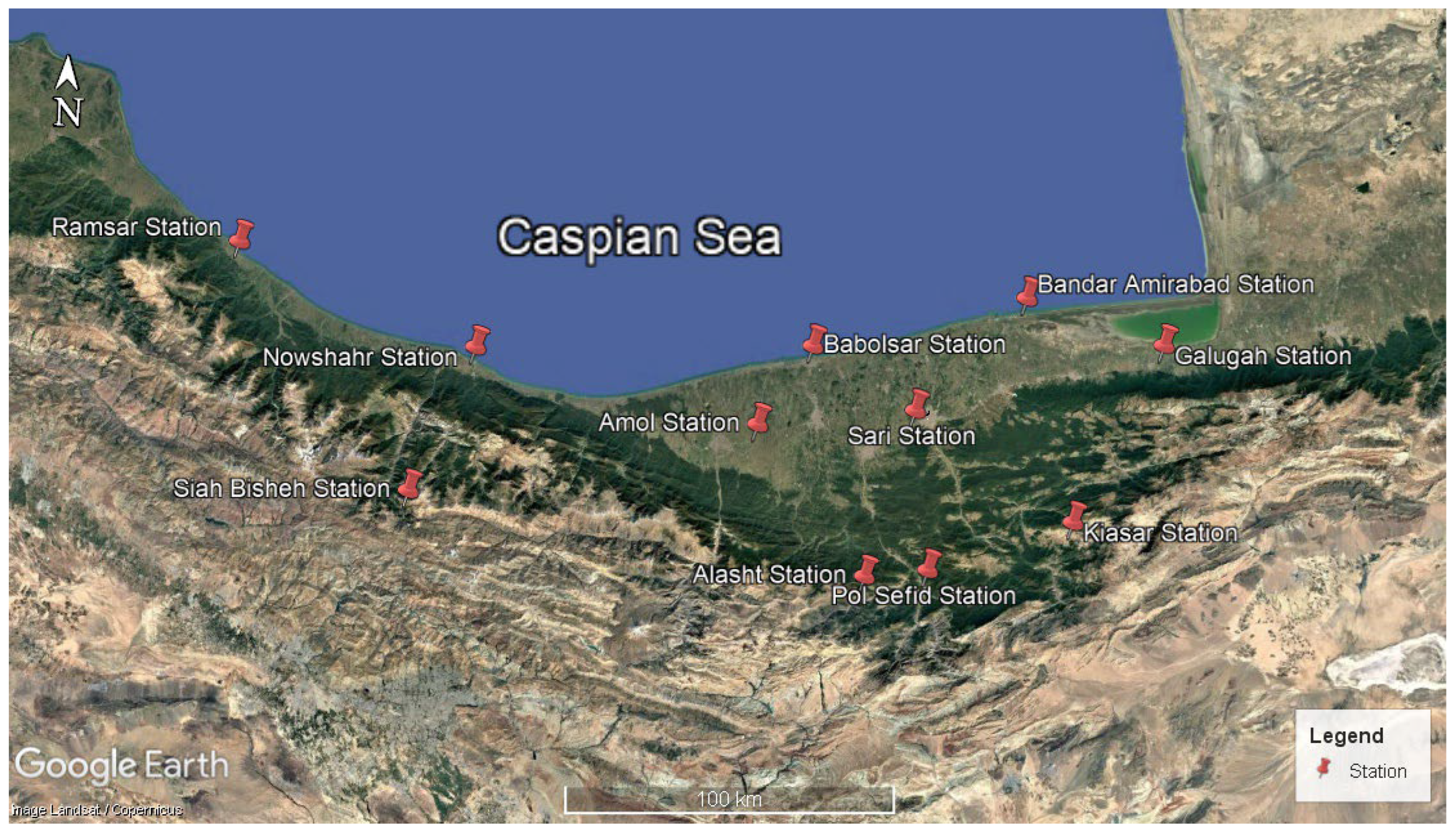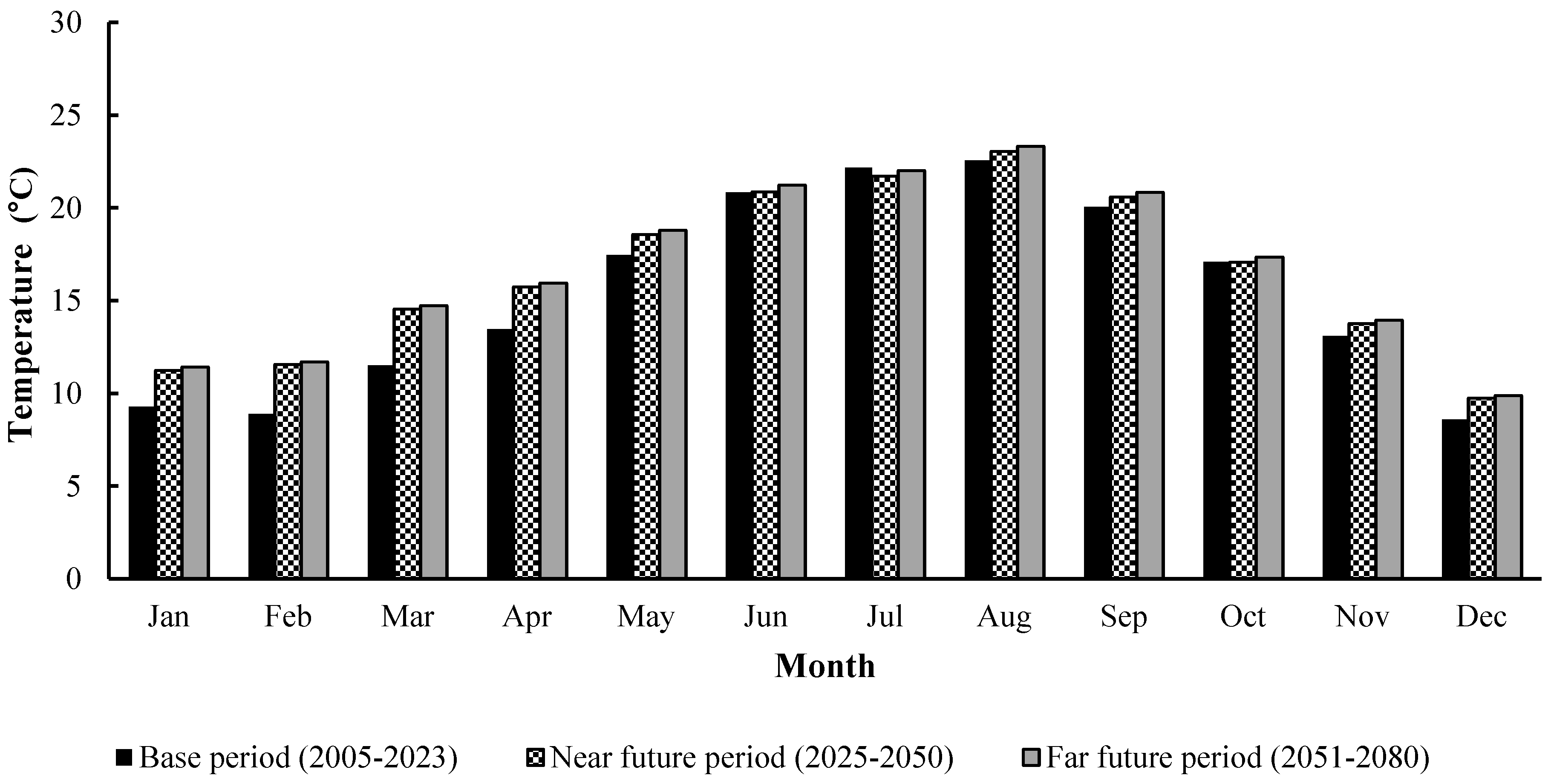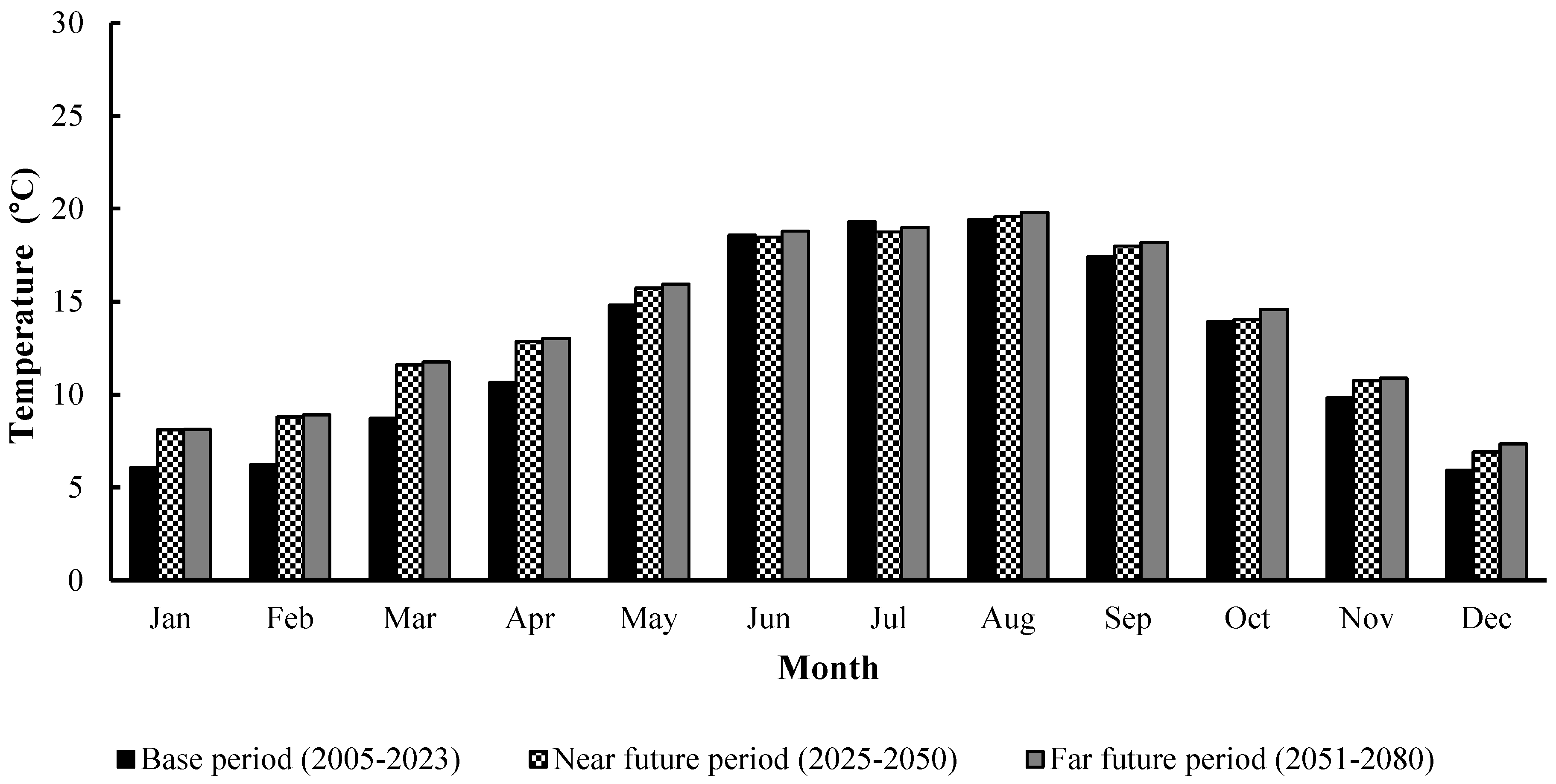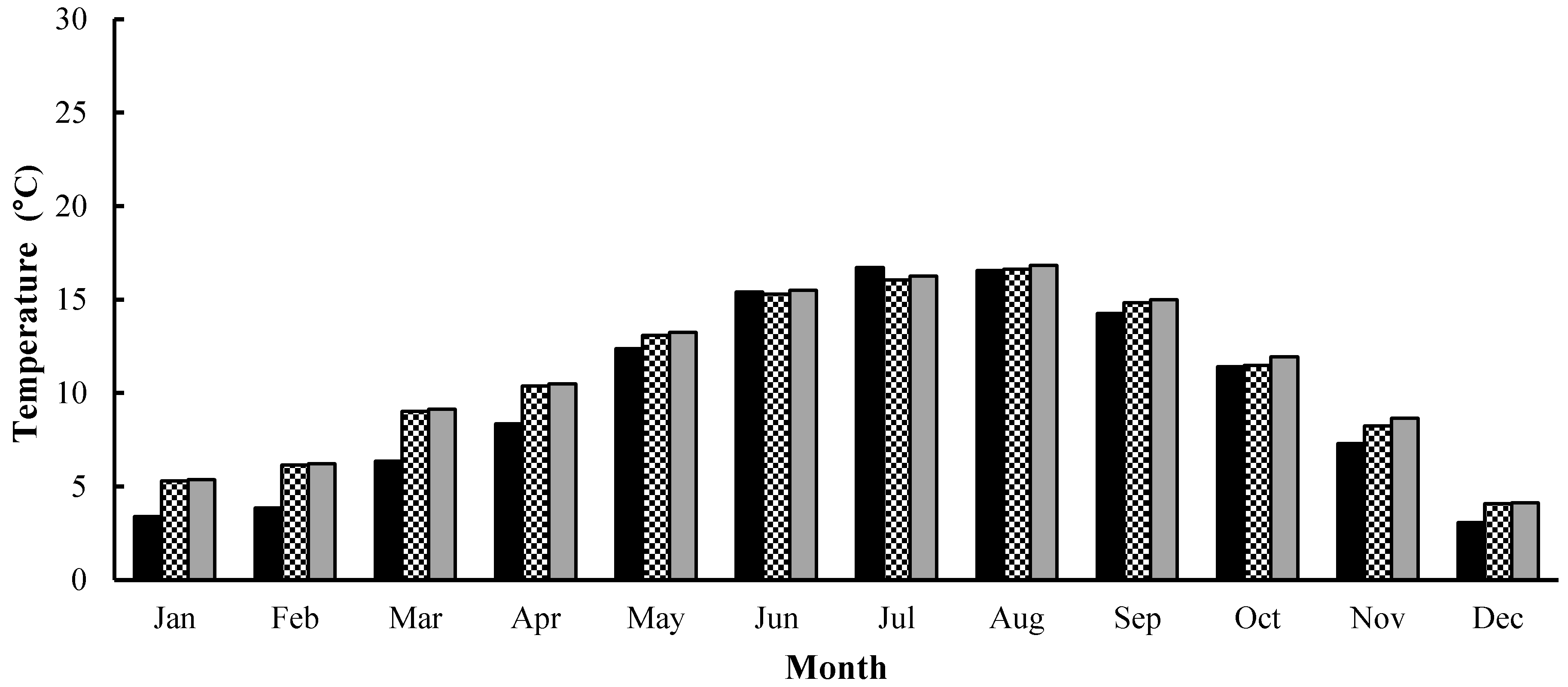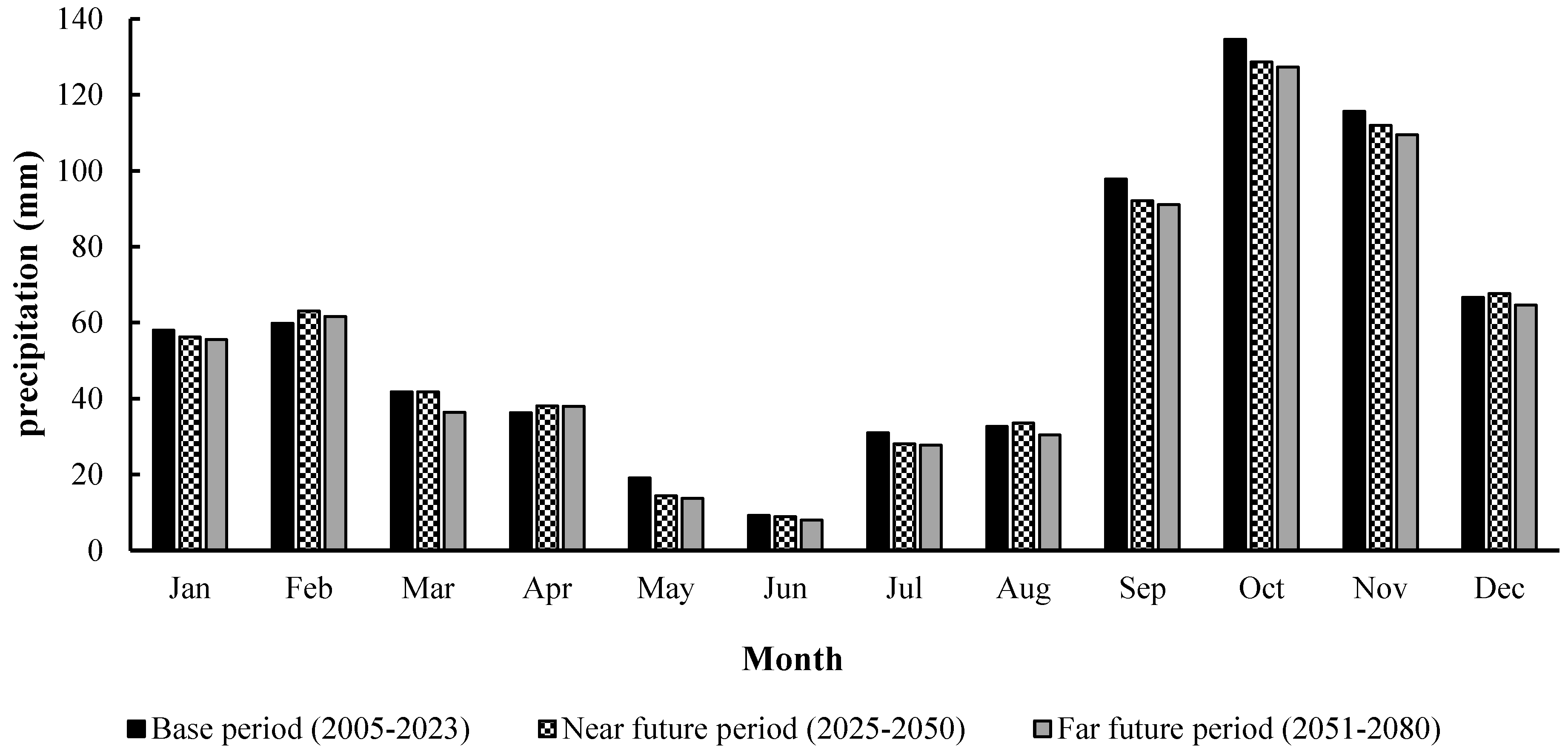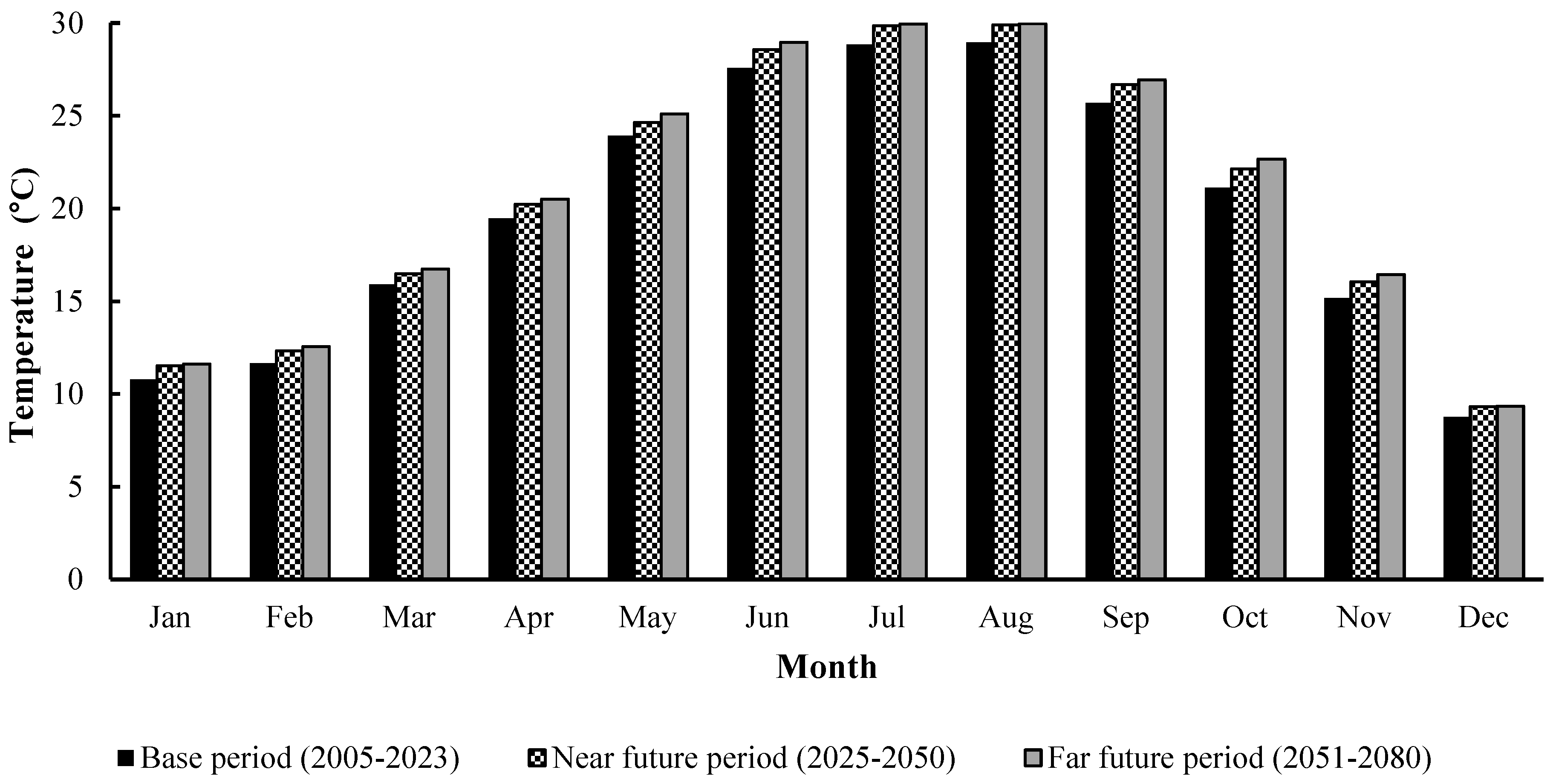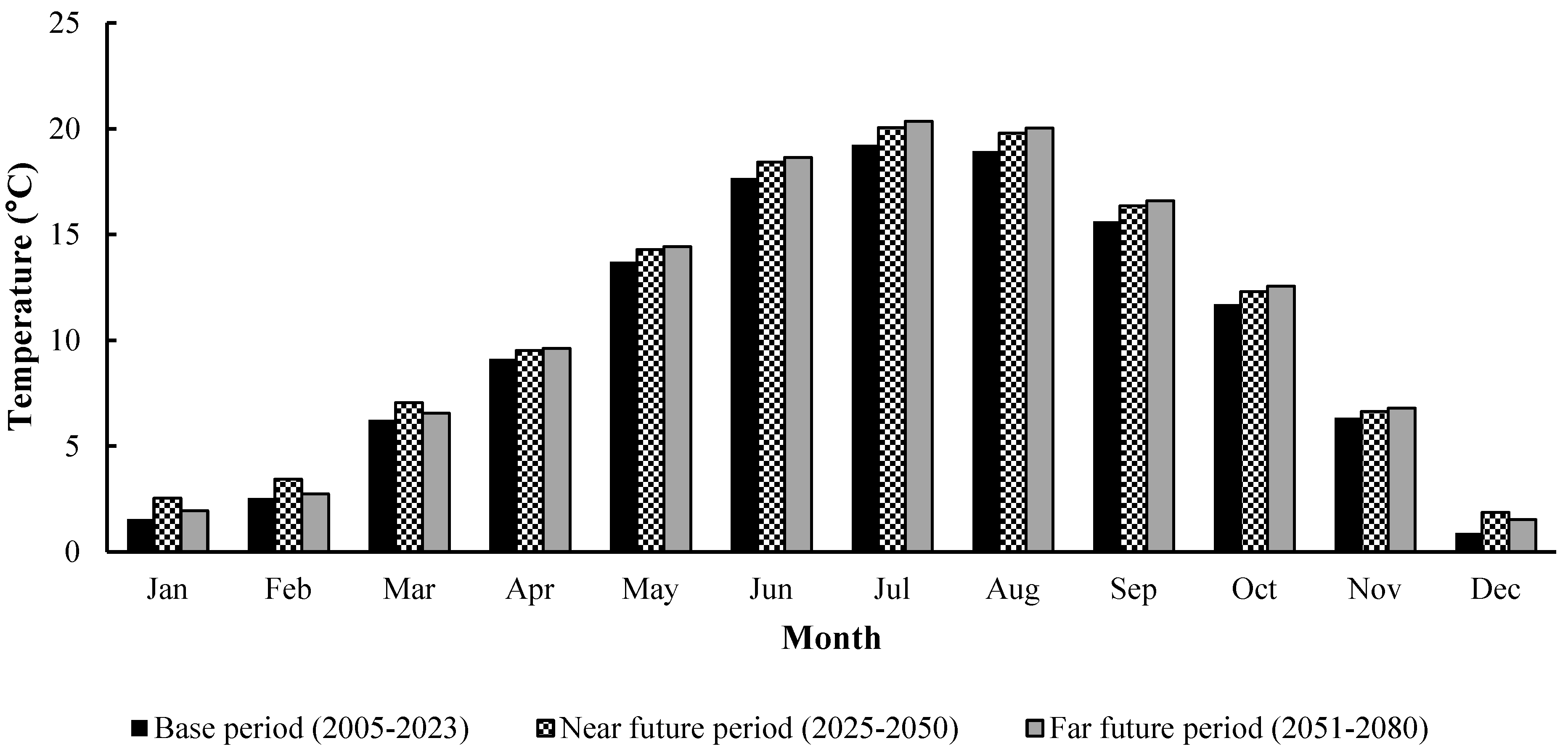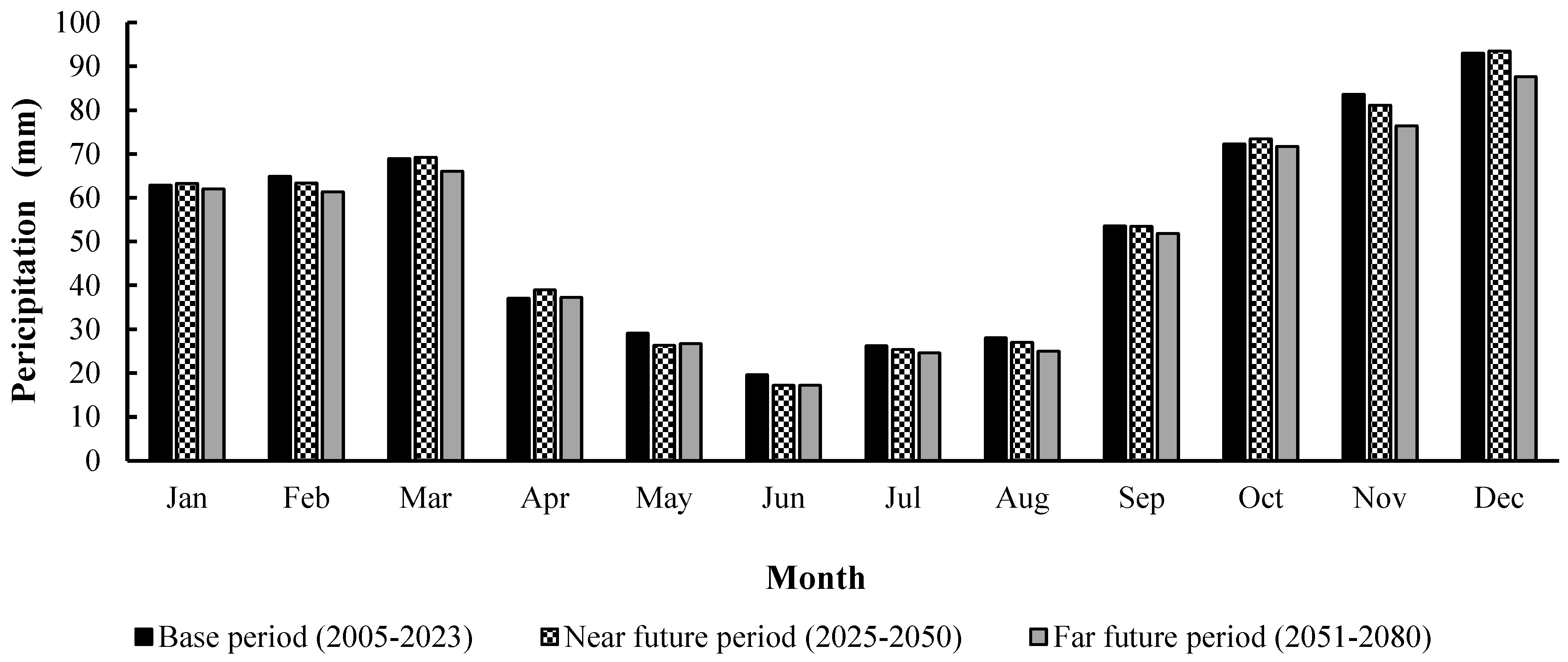1. Introduction
The recent industrialization of societies has led to increased fossil fuel usage, resulting in greenhouse gas emissions [
1], increased global mean temperature, and changes in climatic parameters [
2]. The Fourth Assessment Report of the Intergovernmental Panel on Climate Change (IPCC) predicts global mean temperature increases of approximately 3 °C by 2050 and 4.5 °C by 2100 [
3]. Precipitation plays a crucial and influential role in Earth’s hydrological cycle and ecosystem [
4]. With changes in precipitation amounts, snow and ice have decreased while sea levels have risen. Since the 1980s, high-precipitation regions in both hemispheres have moved closer to the poles. According to IPCC simulations, with temperature increases, precipitation will increase by 2100 in high latitudes, parts of tropical regions, and the Pacific Ocean, but decrease in some subtropical regions [
5]. The increase in greenhouse gas emissions and intensification of climatic parameter changes can negatively impact various systems, including water resources, the environment, industry, health, and agriculture. Although reducing greenhouse gases could mitigate climate change intensity in the future periods, it should be noted that even if all greenhouse gas emissions were to stop immediately, climate change would continue until the late 21st century [
6]. While temperature changes are one of the most apparent and measurable effects of climate change, this phenomenon has other impacts, including changes in atmospheric moisture, precipitation, and atmospheric currents. Generally, temperature increases lead to increased atmospheric moisture retention capacity [
3,
7].
Various studies have shown an increasing trend in air temperature in Iran over the past several decades, confirming the effects of climate change and global warming [
8,
9].
Over the past two decades, several research groups and international collaborative activities, including the IPCC, have presented datasets predicting future global climate conditions using global climate models [
10,
11]. These models are among the most common and appropriate methods for evaluating future climate change impacts [
12,
13]. The IPCC has so far presented six major assessments in three sections: scientific foundations, impacts and adaptation, and climate change mitigation. This international panel presented its First Assessment Report in 1990 and its Sixth Assessment Report in 2016 [
14].
Maghsood et al. [
15] have studied the effects of climate change on the Talar River discharge, in northern Iran, with the IPCC fifth report (CMIP5) using 20 models under two scenarios (RCP2.6 and RCP8.5). The results indicate that under both scenarios, temperature and precipitation will increase for the 2020–2040 period, and increased precipitation will result in higher river discharge and flood risk.
Zhu and Yang [
16] conducted a comparative study of the IPCC Fifth Assessment Report and Sixth Assessment Report to assess the impact of climate change on precipitation and temperature in the Tibetan Plateau. For the period 1961–2014, their research used 23 models. The results showed that the CMIP6 models of the Sixth Assessment Report performed better in predicting temperature and precipitation in arid regions compared to the CMIP5 models, but less so in humid regions.
Doulabian et al. [
17] assessed how climate change affects temperature and precipitation at six synoptic meteorological stations in Iran (Tabriz, Abadan, Babolsar, Iranshahr, Torbat-e Heydarieh, and Yazd). The results showed uncertainty in precipitation projections but indicated that temperature would increase at all selected stations in the future period.
Shafeeque and Luo [
18] investigated the impact of climate change on glaciers in the upper Indus River basin in India. The results revealed simultaneous increases in precipitation and temperature, while glacier area and volume decreased.
Hasheminasab et al. [
19] applied the Fifth Assessment Report (CMIP5) using data from 14 meteorological stations from 1964 to 2014 to analyze the impact of climate change on the Karun River basin (Iran). The results indicated that over the next 50 years, minimum and maximum temperatures in the region would increase and that precipitation would decrease in autumn and winter and increase in spring.
In the context of the Sixth Assessment Report of the IPCC, Goodarzi et al. [
20] examined the impact of climate change on precipitation, minimum temperature, and maximum temperature at two synoptic stations in Gilan Province, northern Iran, for 2016–2100. The models used in this study were CanESM5, IPSL-CM6A-LR, and Miroc6, and the scenarios were SSP119, SSP434, and SSP585. Optimal results were shown by the CanESM5 model under the SSP585 scenario. Both stations would experience a mean maximum and minimum temperature increase of 4 °C. In addition, the precipitation amount would increase, and the number of rainy days would decrease.
Usta et al. [
21] studied the effect of climate change on temperature variations in Iran for 97 synoptic stations under three future scenarios (SSP2-2.6, SSP2-4.5, and SSP5-8.5) in the baseline period (1990–2014). The results showed that the temperature increases in Iran for 2015–2050 and 2051–2100 for all three scenarios.
Mathbout et al. [
22] examined how climate change shaped drought in Syria in 2023. The study employed 13 models and two IPCC Sixth Assessment Report scenarios (SSP2.6 and SSP8.5) as well as baseline period data from 1970 to 2000. It was shown that both scenarios led to temperature increases and precipitation decreases. Syria would also become subjected to more intense droughts with time.
Using the IPCC Sixth Assessment Report and its 37 associated models, precipitation and temperature changes across Iran were examined by Zabihi and Ahmadi [
23]. The results further indicate that the ACCESS CM2, BCC CSM2 MR, and ACCESS ESM1 5 models performed more favorably than the other models for 1985–2014.
Using LARS-WG software, five models and two scenarios (SSP5-8.5, SSP2-4.5) from the IPCC Sixth Assessment Report (CMIP6), Abdulsahib et al. [
24] examined the impact of climate change on precipitation and temperature in northern Iraq. Under the SSP5-8.5 scenario, temperature increases in all seasons and precipitation decreases in all seasons but autumn.
Mazandaran Province is located in the north of Iran. In the east of Mazandaran Province, the distance between the Caspian Sea and Alborz Mountain range is greater than in the west of this province. This characteristic has led to differences in climatic changes, necessitating special consideration for environmental, water resources, and agricultural planning.
Our goals in this study are to predict the impact of climate change in the near and far future on the meteorological parameters (temperature and precipitation) of 11 synoptic stations located in the east and west of Mazandaran Province. In other studies cited in the literature, only coastal stations have been considered. To make this study comprehensive, plain and mountain stations are also added. Also, from the five GCMs (general circulation models) and two scenarios (SSP2-2.6 and SSP5-8.5), the best model for temperature, the best model for precipitation, and the best scenario for each station are selected.
4. Discussion
One of the most important findings of the near future air temperature between the two regions of Mazandaran Province is that the average temperature in the western part will be lower than that in the eastern part (13.68 °C vs. 16.09 °C). Also, in the far future, the average temperature in the west of Mazandaran will be lower than in the east of Mazandaran (13.9 °C vs. 16.19 °C). The short distance between the Caspian Sea and the mountains in the west causes the average temperature to be lower than in the east, while the eastern part of the province has extensive plains between the sea and the mountains.
The above analyses suggest that precipitation will decrease more in the west of Mazandaran Province than in the eastern part and more in the near future than the far future. Monthly precipitation rates, however, are higher in the western part (compare
Figure 5 and
Figure 9), and therefore, the precipitation depth in the western part will be higher than in the eastern part. The eastern part will receive 186.2 mm less annual precipitation in the near future and 181 mm less in the far future than the west.
The comparison of
Table 11 and
Table 12 clearly demonstrates that decreased precipitation in the east of Mazandaran Province, particularly compared to the western region, could have significant implications for the hydrological, agricultural, economic, and social conditions of this area. Reduced precipitation affects surface and groundwater resources and could lead to fundamental changes in the economic and social structure of the region’s inhabitants. For example, the Nekarood River, located in the east of Mazandaran Province, near the Galugah synoptic station, is a vital water source for this region and will be affected by decreased precipitation and increased temperatures. Temperature increase directly leads to increased evaporation, and this river’s flow will significantly decrease alongside reduced precipitation. This situation could result in reduced water input to Gorgan Bay, which currently faces challenges such as water recession, sediment deposition, and problems for Bandar Torkaman in Golestan Province. In addition, increased dust particles in this bay could severely impact the lives of people in the eastern region and threaten their health.
In the case of continuous temperature increase and precipitation decrease, groundwater extraction will increase significantly. This process has already begun, and a 60–70 cm decline in water table levels in the east of Mazandaran Province could accelerate land subsidence. Moreover, increased temperature and Caspian Sea evaporation rates could create economic and maritime transportation problems for important ports such as Babolsar, Bandar Amirabad, and Nowshahr, particularly Amirabad Port, located in the east, which is affected more by these climatic changes.
Decreasing precipitation and increasing temperature affect the quantity and quality of agricultural products, especially rice crop, which is a water-intensive crop [
39,
40,
41]. In addition, temperature increases in winter and autumn could lead to increased weed germination and pest outbreaks in orchards and agricultural lands. Given the dependence of many Mazandaran Province residents on agriculture, these challenges could lead to social and economic crises.
The combination of decreased precipitation and increased temperature could intensify soil moisture deficits [
42]. The presence of Neka cement factory and the thermal power plant in this region could contribute to further warming and negative climate change impacts. Temperature increases cause people to use more cooling systems, leading to increased electricity consumption and thermal power plant operation, which also increases greenhouse gas emissions.
Climate changes and human activities have had profound effects on northern Iran’s ecosystems, causing reduced river flow and water input to the Caspian Sea. Environmental problems such as air pollution and land subsidence have increased in recent years [
43]. Growing housing demand and rapid urbanization have led to the conversion of agricultural lands to urban and industrial settlements and forests being replaced by agricultural lands [
44]. In view of this, there is a need for the adoption of necessary measures of water resources management and climate change adaptation to avoid the fate of these negative consequences.
5. Conclusions
This research aims to better understand the impact of climate change on temperature (maximum, average, and minimum) and precipitation on the east and west of Mazandaran Province, Iran, for the near future (2025–2050) and far future (2051–2080). The study utilizes five GCMs and two scenarios (SSP2-2.6 and SSP5-8.5) from the IPCC Sixth Assessment Report. The IPSL-CM6A-LR model is selected for temperature, and the CNRM-CM6-1 model is chosen for precipitation as the preferred models for Sari and Nowshahr synoptic stations. The overall results of this research are as follows.
In the west of Mazandaran Province, monthly temperature (maximum, average, and minimum) and precipitation variations in both the near and far future, as compared to the baseline period, did not follow a specific pattern. These irregular changes in the western region are attributed to the spatial distribution of synoptic stations relative to the elevation above the Caspian Sea level. Overall, the temperature trend in both the near and far future indicates an increase compared to the baseline period. But the overall trend for precipitation is decreasing.
Monthly temperature predictions for the eastern region in the near and far future also indicate an increasing trend. Here, temperature fluctuations are greater than in the western region. This increase is primarily due to the vast plains between the Alborz Mountain range and the Caspian Sea.
Precipitation changes for the near and far future compared to the baseline period in the eastern region are inconsistent, although the overall trend is decreasing. However, the western region receives more precipitation than the eastern region.
Considering the results of this research along with findings by Chen et al. [
45] and Koriche et al. [
46] regarding increased evaporation from the Caspian Sea, declining water levels, the receding of the southern Caspian Sea water level, and reduced inflow into the Caspian Sea [
47], it appears that climate change will have negative consequences for ports, ecotourism, and land use in Mazandaran Province. Water resources managers in this province must develop comprehensive short-term and long-term plans to optimize surface and groundwater resource utilization.
Furthermore, it is essential to utilize other GCMs and climate change scenarios from the sixth IPCC report as well as additional synoptic stations in Gilan Province and Golestan Province, which are located to the west and east of Mazandaran Province, respectively, to provide a more accurate assessment of climate change in the study area.
Additionally, a more thorough investigation is needed regarding the impact of climate change on meteorological and hydrological droughts and reduced river flows in Mazandaran Province.
Given that some of the stations investigated in this research have statistics of less than 30 years of recorded data, it is recommended to carry out this research again when the data record is at least 30 years old.
Considering the negative effects of climate change in the future in the east and west of Mazandaran Province, it is suggested that collecting surface water, changing the cultivation pattern from water-intensive crops to crops with low water consumption, preventing forest destruction, using clean energy such as solar energy and wind turbines (to reduce electricity production through thermal power plants) should be on the agenda of policymakers in this province.
